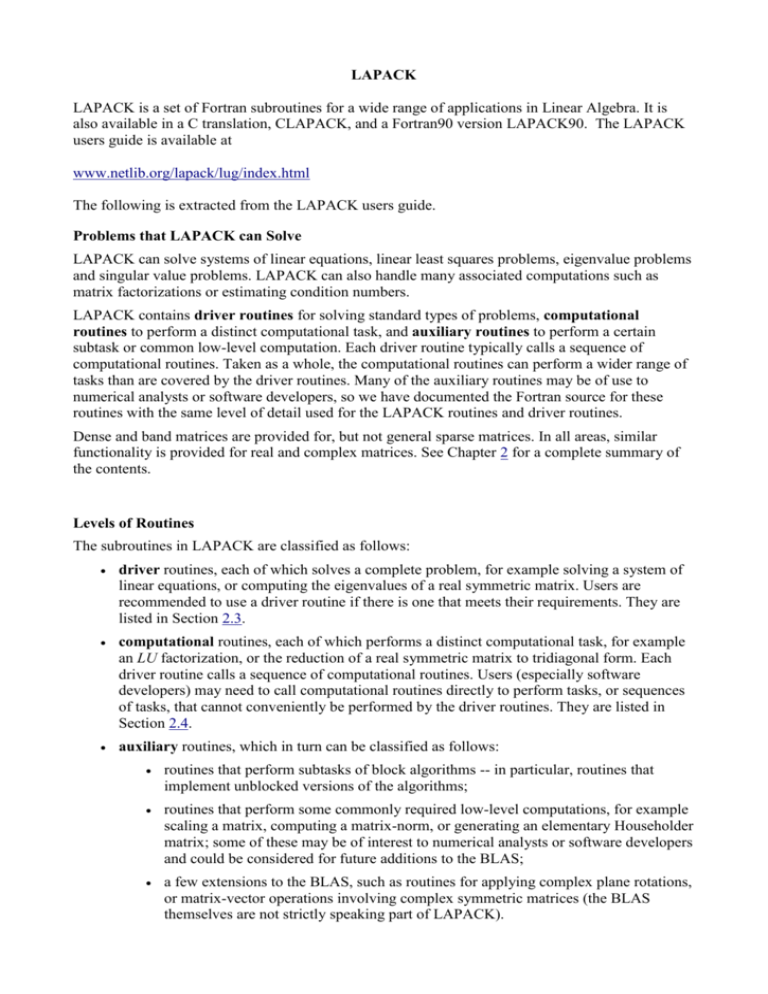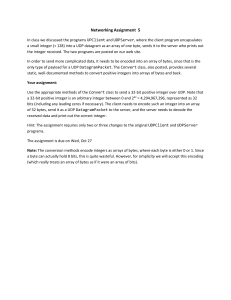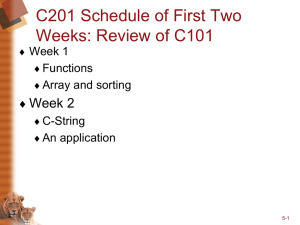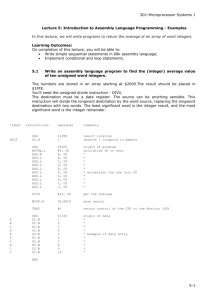LAPACK document
advertisement

LAPACK LAPACK is a set of Fortran subroutines for a wide range of applications in Linear Algebra. It is also available in a C translation, CLAPACK, and a Fortran90 version LAPACK90. The LAPACK users guide is available at www.netlib.org/lapack/lug/index.html The following is extracted from the LAPACK users guide. Problems that LAPACK can Solve LAPACK can solve systems of linear equations, linear least squares problems, eigenvalue problems and singular value problems. LAPACK can also handle many associated computations such as matrix factorizations or estimating condition numbers. LAPACK contains driver routines for solving standard types of problems, computational routines to perform a distinct computational task, and auxiliary routines to perform a certain subtask or common low-level computation. Each driver routine typically calls a sequence of computational routines. Taken as a whole, the computational routines can perform a wider range of tasks than are covered by the driver routines. Many of the auxiliary routines may be of use to numerical analysts or software developers, so we have documented the Fortran source for these routines with the same level of detail used for the LAPACK routines and driver routines. Dense and band matrices are provided for, but not general sparse matrices. In all areas, similar functionality is provided for real and complex matrices. See Chapter 2 for a complete summary of the contents. Levels of Routines The subroutines in LAPACK are classified as follows: driver routines, each of which solves a complete problem, for example solving a system of linear equations, or computing the eigenvalues of a real symmetric matrix. Users are recommended to use a driver routine if there is one that meets their requirements. They are listed in Section 2.3. computational routines, each of which performs a distinct computational task, for example an LU factorization, or the reduction of a real symmetric matrix to tridiagonal form. Each driver routine calls a sequence of computational routines. Users (especially software developers) may need to call computational routines directly to perform tasks, or sequences of tasks, that cannot conveniently be performed by the driver routines. They are listed in Section 2.4. auxiliary routines, which in turn can be classified as follows: routines that perform subtasks of block algorithms -- in particular, routines that implement unblocked versions of the algorithms; routines that perform some commonly required low-level computations, for example scaling a matrix, computing a matrix-norm, or generating an elementary Householder matrix; some of these may be of interest to numerical analysts or software developers and could be considered for future additions to the BLAS; a few extensions to the BLAS, such as routines for applying complex plane rotations, or matrix-vector operations involving complex symmetric matrices (the BLAS themselves are not strictly speaking part of LAPACK). Data Types and Precision LAPACK provides the same range of functionality for real and complex data. For most computations there are matching routines, one for real and one for complex data, but there are a few exceptions. For example, corresponding to the routines for real symmetric indefinite systems of linear equations, there are routines for complex Hermitian and complex symmetric systems, because both types of complex systems occur in practical applications. However, there is no complex analogue of the routine for finding selected eigenvalues of a real symmetric tridiagonal matrix, because a complex Hermitian matrix can always be reduced to a real symmetric tridiagonal matrix. Matching routines for real and complex data have been coded to maintain a close correspondence between the two, wherever possible. However, in some areas (especially the nonsymmetric eigenproblem) the correspondence is necessarily weaker. All routines in LAPACK are provided in both single and double precision versions. The double precision versions have been generated automatically, using Toolpack/1 [88]. Double precision routines for complex matrices require the non-standard Fortran data type COMPLEX*16, which is available on most machines where double precision computation is usual. Naming Scheme The name of each LAPACK routine is a coded specification of its function (within the very tight limits of standard Fortran 77 6-character names). All driver and computational routines have names of the form XYYZZZ, where for some driver routines the 6th character is blank. The first letter, X, indicates the data type as follows: S REAL D DOUBLE PRECISION C COMPLEX Z COMPLEX*16 or DOUBLE COMPLEX When we wish to refer to an LAPACK routine generically, regardless of data type, we replace the first letter by ``x''. Thus xGESV refers to any or all of the routines SGESV, CGESV, DGESV and ZGESV. The next two letters, YY, indicate the type of matrix (or of the most significant matrix). Most of these two-letter codes apply to both real and complex matrices; a few apply specifically to one or the other, as indicated in Table 2.1. Table 2.1: Matrix types in the LAPACK naming scheme BD bidiagonal DI diagonal GB general band GE general (i.e., unsymmetric, in some cases rectangular) GG general matrices, generalized problem (i.e., a pair of general matrices) GT general tridiagonal HB (complex) Hermitian band HE (complex) Hermitian HG upper Hessenberg matrix, generalized problem (i.e a Hessenberg and a triangular matrix) HP (complex) Hermitian, packed storage HS upper Hessenberg OP (real) orthogonal, packed storage OR (real) orthogonal PB symmetric or Hermitian positive definite band PO symmetric or Hermitian positive definite PP symmetric or Hermitian positive definite, packed storage PT symmetric or Hermitian positive definite tridiagonal SB (real) symmetric band SP symmetric, packed storage ST (real) symmetric tridiagonal SY symmetric TB triangular band TG triangular matrices, generalized problem (i.e., a pair of triangular matrices) TP triangular, packed storage TR triangular (or in some cases quasi-triangular) TZ trapezoidal UN (complex) unitary UP (complex) unitary, packed storage When we wish to refer to a class of routines that performs the same function on different types of matrices, we replace the first three letters by ``xyy''. Thus xyySVX refers to all the expert driver routines for systems of linear equations that are listed in Table 2.2. The last three letters ZZZ indicate the computation performed. Their meanings will be explained in Section 2.4. For example, SGEBRD is a single precision routine that performs a bidiagonal reduction (BRD) of a real general matrix. The names of auxiliary routines follow a similar scheme except that the 2nd and 3rd characters YY are usually LA (for example, SLASCL or CLARFG). There are two kinds of exception. Auxiliary routines that implement an unblocked version of a block algorithm have similar names to the routines that perform the block algorithm, with the sixth character being ``2'' (for example, SGETF2 is the unblocked version of SGETRF). A few routines that may be regarded as extensions to the BLAS are named according to the BLAS naming schemes (for example, CROT, CSYR). Driver Routines and Computational Routines Driver Routines Linear Equations Linear Least Squares (LLS) Problems Generalized Linear Least Squares (LSE and GLM) Problems Standard Eigenvalue and Singular Value Problems Symmetric Eigenproblems (SEP) Nonsymmetric Eigenproblems (NEP) Singular Value Decomposition (SVD) Generalized Eigenvalue and Singular Value Problems Generalized Symmetric Definite Eigenproblems (GSEP) Generalized Nonsymmetric Eigenproblems (GNEP) Generalized Singular Value Decomposition (GSVD) Computational Routines Linear Equations Orthogonal Factorizations and Linear Least Squares Problems QR Factorization LQ Factorization QR Factorization with Column Pivoting Complete Orthogonal Factorization Other Factorizations Generalized Orthogonal Factorizations and Linear Least Squares Problems Generalized QR Factorization Generalized RQ Factorization Symmetric Eigenproblems Nonsymmetric Eigenproblems Eigenvalues, Eigenvectors and Schur Factorization Balancing Invariant Subspaces and Condition Numbers Singular Value Decomposition Generalized Symmetric Definite Eigenproblems Generalized Nonsymmetric Eigenproblems Eigenvalues, Eigenvectors and Generalized Schur Decomposition Balancing Deflating Subspaces and Condition Numbers Generalized (or Quotient) Singular Value Decomposition DGETRF(1) LAPACK routine (version 3.1) DGETRF(1) NAME DGETRF - an LU factorization of a general M-by-N matrix A using partial pivoting with row interchanges SYNOPSIS SUBROUTINE DGETRF( M, N, A, LDA, IPIV, INFO ) INTEGER INFO, LDA, M, N INTEGER IPIV( * ) DOUBLE PRECISION A( LDA, * ) PURPOSE DGETRF computes an LU factorization of a general M-by-N matrix A using partial pivoting with row interchanges. The factorization has the form A=P*L*U where P is a permutation matrix, L is lower triangular with unit diagonal elements (lower trapezoidal if m > n), and U is upper triangular (upper trapezoidal if m < n). This is the right-looking Level 3 BLAS version of the algorithm. ARGUMENTS M (input) INTEGER The number of rows of the matrix A. M >= 0. N (input) INTEGER The number of columns of the matrix A. N >= 0. A (input/output) DOUBLE PRECISION array, dimension (LDA,N) On entry, the M-by-N matrix to be factored. On exit, the factors L and U from the factorization A = P*L*U; the unit diagonal elements of L are not stored. LDA (input) INTEGER The leading dimension of the array A. LDA >= max(1,M). IPIV (output) INTEGER array, dimension (min(M,N)) The pivot indices; for 1 <= i <= min(M,N), row i of the matrix was interchanged with row IPIV(i). INFO (output) INTEGER = 0: successful exit < 0: if INFO = -i, the i-th argument had an illegal value > 0: if INFO = i, U(i,i) is exactly zero. The factorization has been completed, but the factor U is exactly singular, and division by zero will occur if it is used to solve a system of equations. DGETRS(1) LAPACK routine (version 3.1) DGETRS(1) NAME DGETRS - a system of linear equations A * X = B or A' * X = B with a general N-by-N matrix A using the LU factorization computed by DGETRF SYNOPSIS SUBROUTINE DGETRS( TRANS, N, NRHS, A, LDA, IPIV, B, LDB, INFO ) CHARACTER TRANS INTEGER INFO, LDA, LDB, N, NRHS INTEGER IPIV( * ) DOUBLE PRECISION A( LDA, * ), B( LDB, * ) PURPOSE DGETRS solves a system of linear equations A * X = B or A' * X = B with a general N-by-N matrix A using the LU factorization computed by DGETRF. ARGUMENTS TRANS (input) CHARACTER*1 Specifies the form of the system of equations: = 'N': A * X = B (No transpose) = 'T': A'* X = B (Transpose) = 'C': A'* X = B (Conjugate transpose = Transpose) N (input) INTEGER The order of the matrix A. N >= 0. NRHS (input) INTEGER The number of right hand sides, i.e., the number of columns of the matrix B. NRHS >= 0. A (input) DOUBLE PRECISION array, dimension (LDA,N) The factors L and U from the factorization A = P*L*U as computed by DGETRF. LDA (input) INTEGER The leading dimension of the array A. LDA >= max(1,N). IPIV (input) INTEGER array, dimension (N) The pivot indices from DGETRF; for 1<=i<=N, row i of the matrix was interchanged with row IPIV(i). B (input/output) DOUBLE PRECISION array, dimension (LDB,NRHS) On entry, the right hand side matrix B. On exit, the solution matrix X. LDB (input) INTEGER The leading dimension of the array B. LDB >= max(1,N). INFO (output) INTEGER = 0: successful exit < 0: if INFO = -i, the i-th argument had an illegal value DGEQP3 - compute a QR factorization with column pivoting of a matrix A SYNOPSIS SUBROUTINE DGEQP3( M, N, A, LDA, JPVT, TAU, WORK, LWORK, INFO ) INTEGER INFO, LDA, LWORK, M, N INTEGER JPVT( * ) DOUBLE PRECISION A( LDA, * ), TAU( * ), WORK( * ) PURPOSE DGEQP3 computes a QR factorization with column pivoting of a matrix A: A*P = Q*R using Level 3 BLAS. ARGUMENTS M (input) INTEGER The number of rows of the matrix A. M >= 0. N (input) INTEGER The number of columns of the matrix A. N >= 0. A (input/output) DOUBLE PRECISION array, dimension (LDA,N) On entry, the M-by-N matrix A. On exit, the upper triangle of the array contains the min(M,N)-by-N upper trapezoidal matrix R; the elements below the diagonal, together with the array TAU, represent the orthogonal matrix Q as a product of min(M,N) elementary reflectors. LDA (input) INTEGER The leading dimension of the array A. LDA >= max(1,M). JPVT (input/output) INTEGER array, dimension (N) On entry, if JPVT(J).ne.0, the J-th column of A is permuted to the front of A*P (a leading column); if JPVT(J)=0, the J-th column of A is a free column. On exit, if JPVT(J)=K, then the J-th column of A*P was the the K-th column of A. TAU (output) DOUBLE PRECISION array, dimension (min(M,N)) The scalar factors of the elementary reflectors. WORK (workspace/output) DOUBLE PRECISION array, dimension (LWORK) On exit, if INFO=0, WORK(1) returns the optimal LWORK. LWORK (input) INTEGER The dimension of the array WORK. LWORK >= 3*N+1. For optimal performance LWORK >= 2*N+( N+1 )*NB, where NB is the optimal blocksize. If LWORK = -1, then a workspace query is assumed; the routine only calculates the optimal size of the WORK array, returns this value as the first entry of the WORK array, and no error message related to LWORK is issued by XERBLA. INFO (output) INTEGER = 0: successful exit. < 0: if INFO = -i, the i-th argument had an illegal value. FURTHER DETAILS The matrix Q is represented as a product of elementary reflectors Q = H(1) H(2) . . . H(k), where k = min(m,n). Each H(i) has the form H(i) = I - tau * v * v' where tau is a real/complex scalar, and v is a real/complex vector with v(1:i-1) = 0 and v(i) = 1; v(i+1:m) is stored on exit in A(i+1:m,i), and tau in TAU(i). Based on contributions by G. Quintana-Orti, Depto. de Informatica, Universidad Jaime I, Spain X. Sun, Computer Science Dept., Duke University, USA DORGQR - generate an M-by-N real matrix Q with orthonormal columns, SYNOPSIS SUBROUTINE DORGQR( M, N, K, A, LDA, TAU, WORK, LWORK, INFO ) INTEGER INFO, K, LDA, LWORK, M, N DOUBLE PRECISION A( LDA, * ), TAU( * ), WORK( * ) PURPOSE DORGQR generates an M-by-N real matrix Q with orthonormal columns, which is defined as the first N columns of a product of K elementary reflectors of order M Q = H(1) H(2) . . . H(k) as returned by DGEQRF. ARGUMENTS M (input) INTEGER The number of rows of the matrix Q. M >= 0. N (input) INTEGER The number of columns of the matrix Q. M >= N >= 0. K (input) INTEGER The number of elementary reflectors whose product defines the matrix Q. N >= K >= 0. A (input/output) DOUBLE PRECISION array, dimension (LDA,N) On entry, the i-th column must contain the vector which defines the elementary reflector H(i), for i = 1,2,...,k, as returned by DGEQRF in the first k columns of its array argument A. On exit, the M-by-N matrix Q. LDA (input) INTEGER The first dimension of the array A. LDA >= max(1,M). TAU (input) DOUBLE PRECISION array, dimension (K) TAU(i) must contain the scalar factor of the elementary reflector H(i), as returned by DGEQRF. WORK (workspace/output) DOUBLE PRECISION array, dimension (LWORK) On exit, if INFO = 0, WORK(1) returns the optimal LWORK. LWORK (input) INTEGER The dimension of the array WORK. LWORK >= max(1,N). For optimum performance LWORK >= N*NB, where NB is the optimal blocksize. If LWORK = -1, then a workspace query is assumed; the routine only calculates the optimal size of the WORK array, returns this value as the first entry of the WORK array, and no error message related to LWORK is issued by XERBLA. INFO (output) INTEGER = 0: successful exit < 0: if INFO = -i, the i-th argument has an illegal value DGESVD - compute the singular value decomposition (SVD) of a real M-byN matrix A, optionally computing the left and/or right singular vectors SYNOPSIS SUBROUTINE DGESVD( JOBU, JOBVT, M, N, A, LDA, S, U, LDU, VT, LDVT, WORK, LWORK, INFO ) CHARACTER JOBU, JOBVT INTEGER INFO, LDA, LDU, LDVT, LWORK, M, N DOUBLE PRECISION A( LDA, * ), S( * ), U( LDU, * ), VT( LDVT, * ), WORK( * ) PURPOSE DGESVD computes the singular value decomposition (SVD) of a real M-by-N matrix A, optionally computing the left and/or right singular vectors. The SVD is written A = U * SIGMA * transpose(V) where SIGMA is an M-by-N matrix which is zero except for its min(m,n) diagonal elements, U is an M-by-M orthogonal matrix, and V is an N-by-N orthogonal matrix. The diagonal elements of SIGMA are the singular values of A; they are real and non-negative, and are returned in descending order. The first min(m,n) columns of U and V are the left and right singular vectors of A. Note that the routine returns V**T, not V. ARGUMENTS JOBU (input) CHARACTER*1 Specifies options for computing all or part of the matrix U: = 'A': all M columns of U are returned in array U: = 'S': the first min(m,n) columns of U (the left singular vectors) are returned in the array U; = 'O': the first min(m,n) columns of U (the left singular vectors) are overwritten on the array A; = 'N': no columns of U (no left singular vectors) are computed. JOBVT (input) CHARACTER*1 Specifies options for computing all or part of the matrix V**T: = 'A': all N rows of V**T are returned in the array VT; = 'S': the first min(m,n) rows of V**T (the right singular vectors) are returned in the array VT; = 'O': the first min(m,n) rows of V**T (the right singular vectors) are overwritten on the array A; = 'N': no rows of V**T (no right singular vectors) are computed. JOBVT and JOBU cannot both be 'O'. M (input) INTEGER The number of rows of the input matrix A. M >= 0. N (input) INTEGER The number of columns of the input matrix A. N >= 0. A (input/output) DOUBLE PRECISION array, dimension (LDA,N) On entry, the M-by-N matrix A. On exit, if JOBU = 'O', A is overwritten with the first min(m,n) columns of U (the left singular vectors, stored columnwise); if JOBVT = 'O', A is overwritten with the first min(m,n) rows of V**T (the right singular vectors, stored rowwise); if JOBU .ne. 'O' and JOBVT .ne. 'O', the contents of A are destroyed. LDA (input) INTEGER The leading dimension of the array A. LDA >= max(1,M). S (output) DOUBLE PRECISION array, dimension (min(M,N)) The singular values of A, sorted so that S(i) >= S(i+1). U (output) DOUBLE PRECISION array, dimension (LDU,UCOL) (LDU,M) if JOBU = 'A' or (LDU,min(M,N)) if JOBU = 'S'. If JOBU = 'A', U contains the M-by-M orthogonal matrix U; if JOBU = 'S', U contains the first min(m,n) columns of U (the left sin- gular vectors, stored columnwise); if JOBU = 'N' or 'O', U is not referenced. LDU (input) INTEGER The leading dimension of the array U. LDU >= 1; if JOBU = 'S' or 'A', LDU >= M. VT (output) DOUBLE PRECISION array, dimension (LDVT,N) If JOBVT = 'A', VT contains the N-by-N orthogonal matrix V**T; 'S', VT contains the first min(m,n) rows of V**T if JOBVT = (the right singular vectors, stored rowwise); if JOBVT = 'N' or 'O', VT is not referenced. LDVT (input) INTEGER The leading dimension of the array VT. LDVT >= 1; if JOBVT = 'A', LDVT >= N; if JOBVT = 'S', LDVT >= min(M,N). WORK (workspace/output) DOUBLE PRECISION array, dimension (LWORK) On exit, if INFO = 0, WORK(1) returns the optimal LWORK; if INFO > 0, WORK(2:MIN(M,N)) contains the unconverged superdiagonal elements of an upper bidiagonal matrix B whose diagonal is in S (not necessarily sorted). B satisfies A = U * B * VT, so it has the same singular values as A, and singular vectors related by U and VT. LWORK (input) INTEGER The dimension of the array WORK. LWORK >= 1. LWORK >= MAX(3*MIN(M,N)+MAX(M,N),5*MIN(M,N)). For good performance, LWORK should generally be larger. If LWORK = -1, then a workspace query is assumed; the routine only calculates the optimal size of the WORK array, returns this value as the first entry of the WORK array, and no error message related to LWORK is issued by XERBLA. INFO (output) INTEGER = 0: successful exit. < 0: if INFO = -i, the i-th argument had an illegal value. > 0: if DBDSQR did not converge, INFO specifies how many superdiagonals of an intermediate bidiagonal form B did not converge to zero. See the description of WORK above for details.





